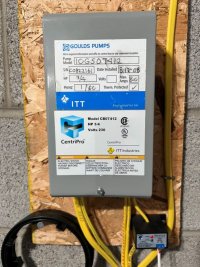Hi all. Would appreciate any ideas on a very strange well issue that occurred for me this morning. Sorry for the length - hoping the detail might help.
Background: 15-year old new construction with deep well in central PA. Unsure of depth. Goulds 3/4 hp submersible, 20 gal pressure tank, 40/60 in/out settings. CPVC piped home and outdoor irrigation system fed from the same well (backflow protected). Never any issues with the pump, tank, well recovery, or well running dry during the last 10 years we've been in the home, even during some significant drought situations.
and outdoor irrigation system fed from the same well (backflow protected). Never any issues with the pump, tank, well recovery, or well running dry during the last 10 years we've been in the home, even during some significant drought situations.
Situation: This morning we woke to find a considerable amount of air in our home's piping which must have occurred overnight.
My suspicion: Our irrigation runs overnight a few times a week for about 2-3 hours. Last night our irrigation started, and about 1/2 hour in, the system lost flow and pressure. With valves to the in-ground lines open, and no pressure from the well, the plumbing system drained down from the house and in to the yard. About an hour later, the flow/pressure returned and the irrigation resumed operating, and the lines in the house re-filled, trapping air.
Evidence: I continuously monitor current draw by the pump. My irrigation is designed to run the well system without pump cycling - it's designed for full pump flow, and the pump stays on until the system shuts down. At about 1/2 hour in, I see pump power consumption briefly increase from a typical 1700W up to 2500W, and then it drops down to about 20W for the next hour before returning. The pump normally shows 0W when it's fully idle, so it appears to have been trying to run during that time.
When I woke and realized something was wrong, I immediately changed all filters (house only, none on the irrigation lines), drained the pressure tank, and checked the pressure on the bladder with the tank empty and open (was at 32 psi and I increased it to 38, which is 2 psi below the cut-in pressure). Once the air cleared from the house, all has been good.
What I can't figure out is WHY this happened. My guess is that the well level might have dropped below the pump for that one hour period. Or pump lost prime or bound up. Or plugged up at the inlet. And then suddenly recovered. I would think if there were a blockage on the discharge side of the pump, I'd see high power consumption and not low like I did.
Any guesses as to why this happened?
And any concerns for the piping in the house? If the plumbing siphoned out in to the irrigation system, I would think it would have had to have created a vacuum in the piping, and I don't know what kind of damage that can cause to CPVC (which is already an issue), hoses, valves, and fittings.
Thanks!
Background: 15-year old new construction with deep well in central PA. Unsure of depth. Goulds 3/4 hp submersible, 20 gal pressure tank, 40/60 in/out settings. CPVC piped home
Situation: This morning we woke to find a considerable amount of air in our home's piping which must have occurred overnight.
My suspicion: Our irrigation runs overnight a few times a week for about 2-3 hours. Last night our irrigation started, and about 1/2 hour in, the system lost flow and pressure. With valves to the in-ground lines open, and no pressure from the well, the plumbing system drained down from the house and in to the yard. About an hour later, the flow/pressure returned and the irrigation resumed operating, and the lines in the house re-filled, trapping air.
Evidence: I continuously monitor current draw by the pump. My irrigation is designed to run the well system without pump cycling - it's designed for full pump flow, and the pump stays on until the system shuts down. At about 1/2 hour in, I see pump power consumption briefly increase from a typical 1700W up to 2500W, and then it drops down to about 20W for the next hour before returning. The pump normally shows 0W when it's fully idle, so it appears to have been trying to run during that time.
When I woke and realized something was wrong, I immediately changed all filters (house only, none on the irrigation lines), drained the pressure tank, and checked the pressure on the bladder with the tank empty and open (was at 32 psi and I increased it to 38, which is 2 psi below the cut-in pressure). Once the air cleared from the house, all has been good.
What I can't figure out is WHY this happened. My guess is that the well level might have dropped below the pump for that one hour period. Or pump lost prime or bound up. Or plugged up at the inlet. And then suddenly recovered. I would think if there were a blockage on the discharge side of the pump, I'd see high power consumption and not low like I did.
Any guesses as to why this happened?
And any concerns for the piping in the house? If the plumbing siphoned out in to the irrigation system, I would think it would have had to have created a vacuum in the piping, and I don't know what kind of damage that can cause to CPVC (which is already an issue), hoses, valves, and fittings.
Thanks!

